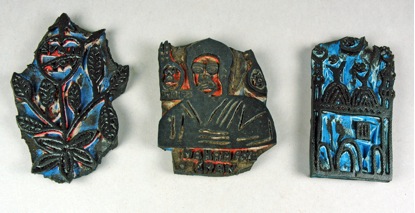African body stamps
 Collected and donated by Anne Haour in 2000; 2000.13.1–.3Body stamps made from old flip-flops, Niger, c. 1999
Collected and donated by Anne Haour in 2000; 2000.13.1–.3Body stamps made from old flip-flops, Niger, c. 1999
These stamps, used for printing a design on the skin, have been crafted out of old rubber flip-flop sandals.
They donor, archaeologist Anne Haour, purchased them from a market in the town of Zinder in southern Niger in 1999. The stallholder normally sold imprints (rather than the stamps themselves) for a price equivalent to two British pence, mainly to children who stamped their arms. According to Haour, flip-flops were widely worn among the local people and despite their low cost, were repeatedly mended and worn until they fell apart. Eventually, the rubber might be reused for other purposes, as in the case of these stamps.
The stamps are made in the same way as linocut, where a knife, chisel or gouge is used to create a raised, mirror image of the design. This is then inked with a roller or else impressed into a tray of dark pigment. The stamp on the left shows a floral pattern and the one on the right shows a mosque. The one in the centre takes the form a man and was intended as a statement of support for the presidential candidate Mahamane Ousmane.
Ousmane (b. 1950) had been in power before, as the first democratically elected president of Niger in 1993. After being ousted by a military coup d'état in 1996 he remained politically active, championing reforms in economics, suffrage and human rights, despite threats of arrest and exile. He has run unsuccessfully in several presidential campaigns since 1996 as the candidate for the Democratic and Social Convention-Rahama Party (CDS). In the 2011 elections he finished fourth with around 8% of the vote.
